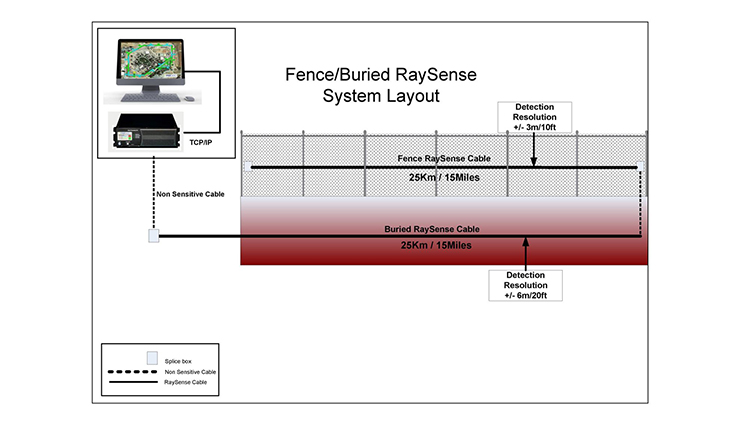The Ultimate Overview to Fiber Optic Safety And Security Systems for Your Business
In a period where protection problems are paramount for services, recognizing the ins and outs of fiber optic modern technology can be transformative. This guide outlines exactly how incorporating fiber optic safety systems not only improves information security however additionally supplies benefits like resistance to disturbance and real-time tracking capabilities. As organizations review their protection requires, it ends up being critical to take into consideration the installation process and the most up to date developments in the field. What particular variables should be focused on when selecting the best system, and how can services guarantee they make the most enlightened choices?
Comprehending Fiber Optic Innovation

The core of a fiber optic wire consists of a slim glass or plastic center, surrounded by a cladding layer that shows light back right into the core. Single-mode fibers are developed for long-distance transmission, while multi-mode fibers are appropriate for much shorter distances, often made use of within structures.
Optical fiber are not only much faster however likewise extra safe than standard wiring. Their fundamental resistance to electromagnetic disturbance and the trouble of taking advantage of the signal without discovery make them a recommended choice for organizations focusing on information stability and security. As organizations progressively count on safe and secure and efficient communication systems, understanding fiber optic innovation comes to be necessary for informed decision-making.
Secret Benefits of Fiber Optic Safety
When considering protection choices for a business, the advantages of fiber optic systems are particularly engaging. Firstly, fiber optic technology provides extraordinary data transmission rates and bandwidth capacity, making it excellent for handling high-resolution video clip feeds from surveillance electronic cameras. This capacity makes sure that protection personnel get real-time information, improving total response times to prospective protection risks.
Moreover, fiber optic cables are naturally immune to electro-magnetic interference, which can jeopardize the integrity of standard copper-based systems. This resistance makes sure that the information sent remains safe and undisturbed, giving a much more trustworthy safety facilities. In addition, fiber optics are less susceptible to physical damages, as they are made from glass instead of steel, minimizing upkeep costs and downtime.
One more significant benefit is the enhanced scalability of fiber optic systems. As organization demands progress, fiber networks can be conveniently broadened to suit added protection devices without significant overhauls to the existing facilities. Fiber optic systems offer enhanced cybersecurity functions, consisting of file encryption capacities that safeguard sensitive information from unauthorized accessibility. Jointly, these benefits make fiber optic safety systems webpage a robust choice for businesses seeking to improve their security procedures.
Installment Process and Considerations
Considering the complexities included, the installation procedure of fiber optic safety and security systems requires mindful preparation and implementation. The preliminary action involves an extensive website assessment to recognize ideal areas for cabling and equipment. This assessment should consider environmental aspects, existing framework, and possible vulnerabilities.

In addition, the installment has to adhere to local building ordinance and market criteria. This might include collaborating with numerous stakeholders such as structure supervisors, IT teams, and safety and security employees to make certain seamless assimilation with existing systems.
Post-installation, extensive testing is essential to validate system performance and identify any concerns that may occur. By focusing on these considerations during the setup procedure, companies can make sure a durable and effective fiber optic security system that meets their specific safety and have a peek here security needs.
Latest Technologies in Fiber Optic Safety And Security
Recent improvements in fiber optic technology have substantially improved the capabilities of safety and security systems for businesses. Among the most significant technologies is the combination of fiber optic sensors that can discover vibrations and breaches along the perimeter of a facility. These sensors supply real-time tracking, making it possible for rapid action to prospective violations.
Additionally, the advancement of dispersed fiber optic picking up modern technology permits the constant surveillance of large locations with a solitary fiber cable television. This approach not only reduces installment expenses yet additionally enhances the reliability of checking systems by getting rid of the requirement for numerous, separate sensors.
Furthermore, developments in multiplexing strategies have actually made it possible for businesses to transfer large quantities of information over fiber optic networks, improving the abilities of video clip security systems. High-definition video feeds can now be sent out over cross countries without loss of top quality, guaranteeing that security workers have accessibility to clear and actionable details.
Last but not least, using expert system (AI) in combination with fiber optic systems is transforming hazard discovery. AI formulas can assess data from fiber optic networks to identify unusual patterns or behaviors, permitting proactive protection measures. These technologies jointly represent a significant leap onward in fiber optic safety and security innovation.
Selecting the Right System for Your Service
Selecting the suitable fiber optic safety system for your company is crucial for guaranteeing optimal defense and assurance. To make an informed choice, evaluate your specific safety and security needs, considering elements such as the size of your facilities, the nature of your operations, and possible vulnerabilities.
Begin by assessing the level of security called for; for example, risky settings may demand advanced systems with visit the website integrated monitoring and intrusion detection capabilities. Next, consider scalability; as your service grows, your security system must can broadening to suit raised demands without considerable overhauls.
Furthermore, check out the dependability and efficiency of various systems. Search for providers with well-known credibilities and client endorsements that testify to their solution quality. It's likewise advisable to inquire regarding the modern technology's compatibility with existing facilities, ensuring a smooth assimilation procedure.
Conclusion
In final thought, fiber optic protection systems present a robust option for enhancing business security frameworks. The most current innovations better reinforce the performance of these systems, making certain that companies continue to be secure and adaptable in an ever-evolving threat landscape.